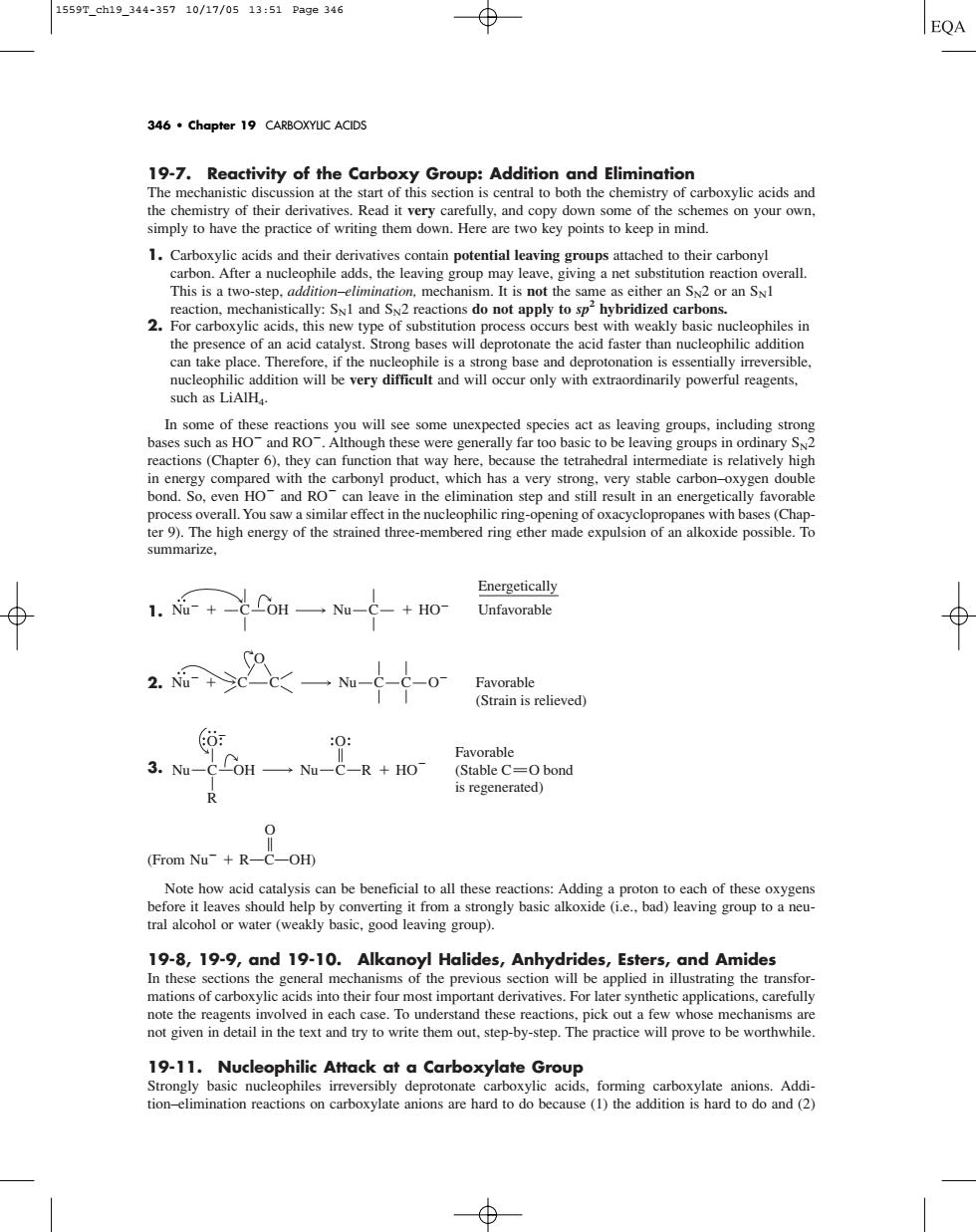正在加载图片...

1559r.ch19_344-35710/17/0513:51Page346 EQA 346.chapter 19 CARBOXYUC ACIDS 19-7.Reactivity of the Carboxy Group:Addition and Elimination down some of the simply to have the practice of writing them down.Here are two key points to keep in mind. 1.Carbox potential leav m.It is not the sam as either an SN2 or an SN 2.Feaction,me edo not apply to sphy cleophiles ir the presence of an acid catalyst.Strong bases will deprotonate the acid faster than nucleophilic addition can take place nbase and deprotonati rily pow such as LiAlH. reaction().then function that where.peeause the intermediate is relativelyhig energy compared with the carbonyl product.ch has a veryonr nerset nd.So.even e in the enm onstep and y la ith er).The high energy of the strained three-membered ring ether made possible.To Energetically 1.+OH一N-+H 2 (Strain is relieved) Favorable 3.Nu- R +HO- (Stab s bond (From Nu-+R-C-OH) Note how acid catalysis can be beneficial to all these reactions:Adding a proton to each of these oxygens eaving group 19-8,19-9,and 19-10.Alkanoyl Halides,Anhydrides,Esters,and Amides In these sections te previo secton wil be applied note in each case.To understand these reactions,pick outa few whose mechanismsar not given in detail in the text and try to write them out.step-by-step.The practice will prove to be worthwhile 19-11.Nucleophilic Attack at a Carboxylate Group Strongly basic nucleophiles irreversibly deprotonate19-7. Reactivity of the Carboxy Group: Addition and Elimination The mechanistic discussion at the start of this section is central to both the chemistry of carboxylic acids and the chemistry of their derivatives. Read it very carefully, and copy down some of the schemes on your own, simply to have the practice of writing them down. Here are two key points to keep in mind. 1. Carboxylic acids and their derivatives contain potential leaving groups attached to their carbonyl carbon. After a nucleophile adds, the leaving group may leave, giving a net substitution reaction overall. This is a two-step, addition–elimination, mechanism. It is not the same as either an SN2 or an SN1 reaction, mechanistically: SN1 and SN2 reactions do not apply to sp2 hybridized carbons. 2. For carboxylic acids, this new type of substitution process occurs best with weakly basic nucleophiles in the presence of an acid catalyst. Strong bases will deprotonate the acid faster than nucleophilic addition can take place. Therefore, if the nucleophile is a strong base and deprotonation is essentially irreversible, nucleophilic addition will be very difficult and will occur only with extraordinarily powerful reagents, such as LiAlH4. In some of these reactions you will see some unexpected species act as leaving groups, including strong bases such as HO and RO. Although these were generally far too basic to be leaving groups in ordinary SN2 reactions (Chapter 6), they can function that way here, because the tetrahedral intermediate is relatively high in energy compared with the carbonyl product, which has a very strong, very stable carbon–oxygen double bond. So, even HO and RO can leave in the elimination step and still result in an energetically favorable process overall. You saw a similar effect in the nucleophilic ring-opening of oxacyclopropanes with bases (Chapter 9). The high energy of the strained three-membered ring ether made expulsion of an alkoxide possible. To summarize, 1. 2. 3. O B (From Nu ROCOOH) Note how acid catalysis can be beneficial to all these reactions: Adding a proton to each of these oxygens before it leaves should help by converting it from a strongly basic alkoxide (i.e., bad) leaving group to a neutral alcohol or water (weakly basic, good leaving group). 19-8, 19-9, and 19-10. Alkanoyl Halides, Anhydrides, Esters, and Amides In these sections the general mechanisms of the previous section will be applied in illustrating the transformations of carboxylic acids into their four most important derivatives. For later synthetic applications, carefully note the reagents involved in each case. To understand these reactions, pick out a few whose mechanisms are not given in detail in the text and try to write them out, step-by-step. The practice will prove to be worthwhile. 19-11. Nucleophilic Attack at a Carboxylate Group Strongly basic nucleophiles irreversibly deprotonate carboxylic acids, forming carboxylate anions. Addition–elimination reactions on carboxylate anions are hard to do because (1) the addition is hard to do and (2) HO Nu R R C O Nu OH C O bond Favorable (Stable C is regenerated) O O Nu C C Nu O C Favorable (Strain is relieved) C HO Nu C OH Nu C Unfavorable Energetically 346 • Chapter 19 CARBOXYLIC ACIDS 1559T_ch19_344-357 10/17/05 13:51 Page 346�����